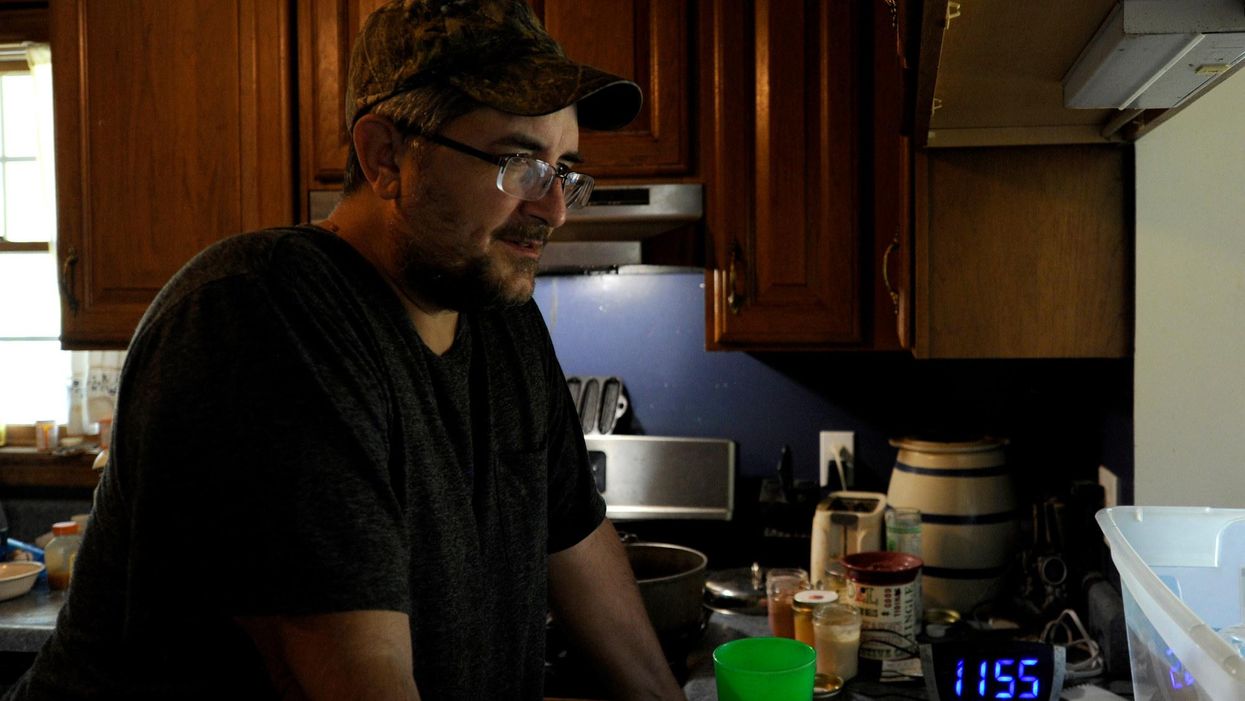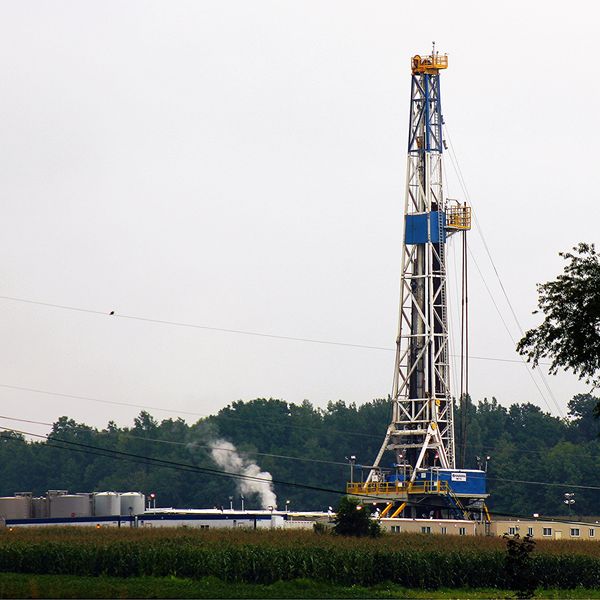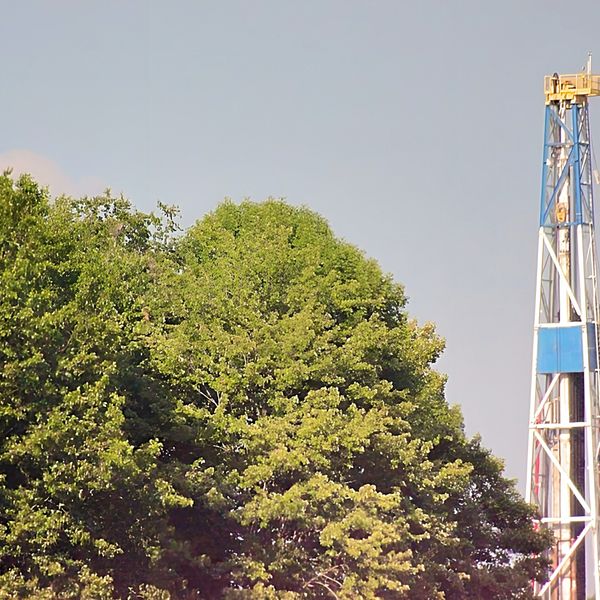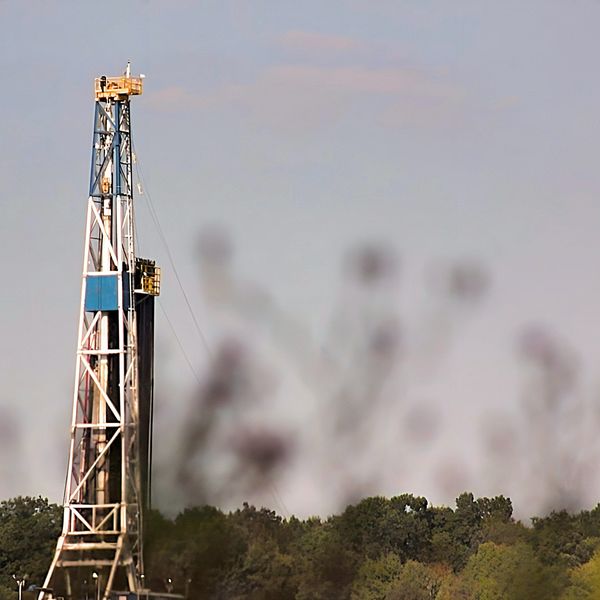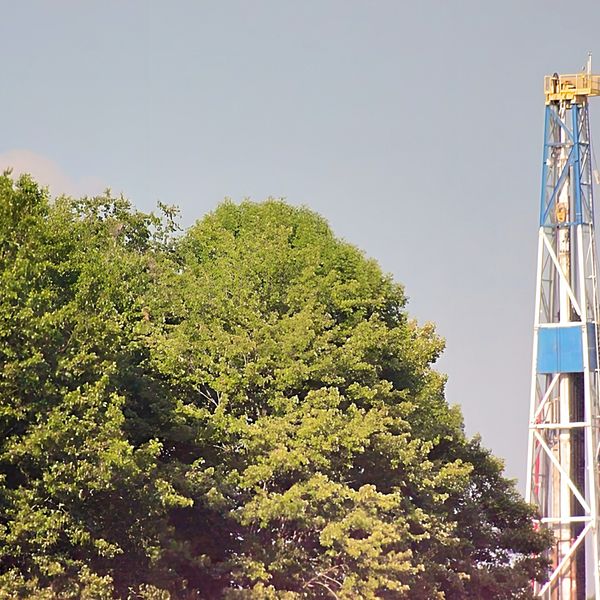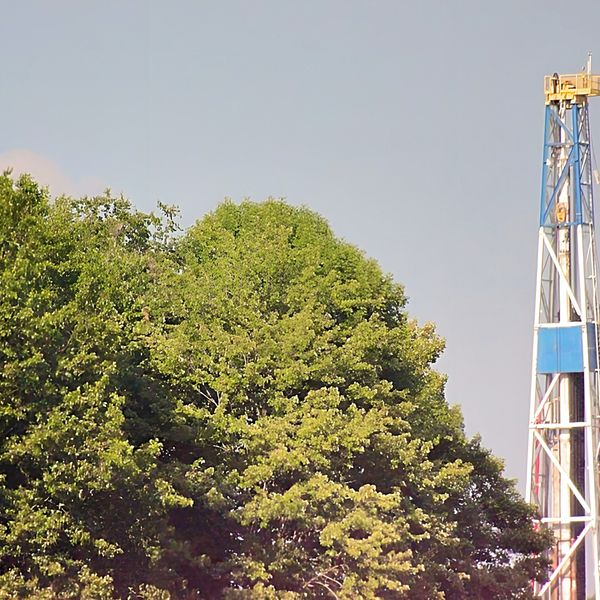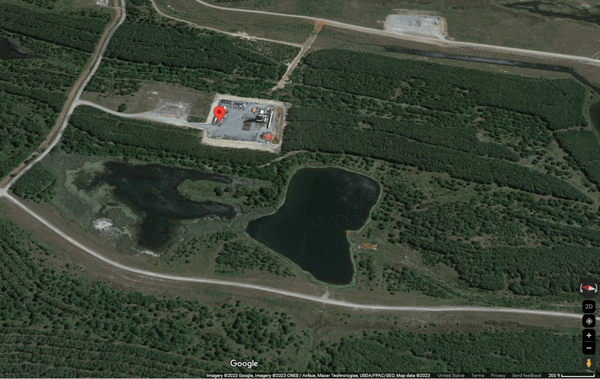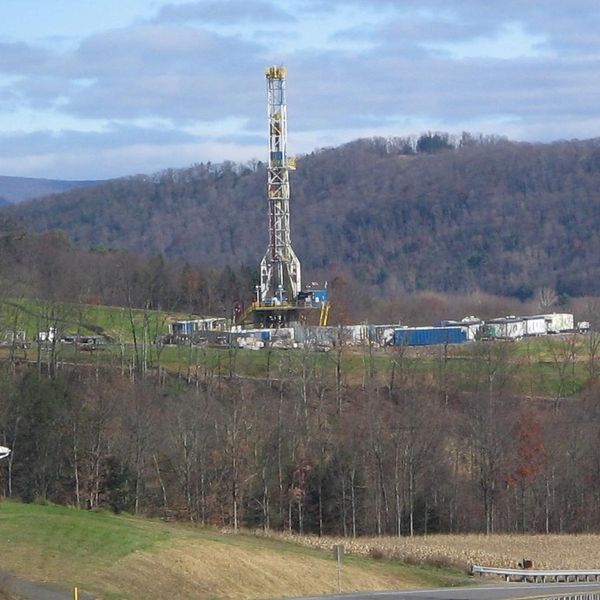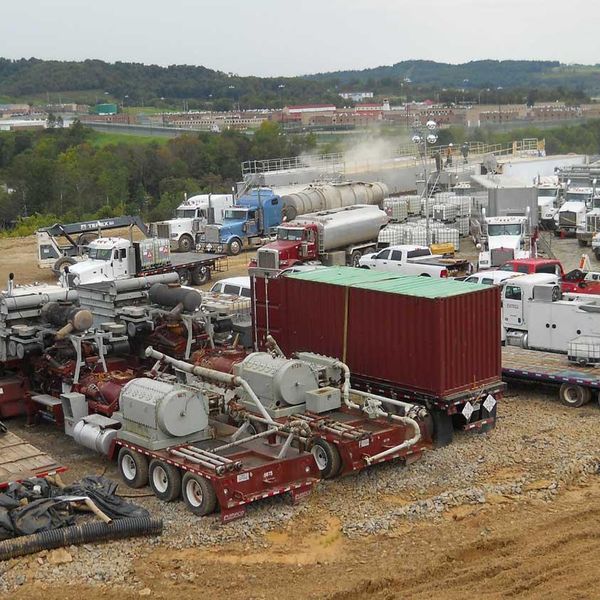This is part 3 of our 4-part series, "Fractured," an investigation of fracking chemicals in the air, water, and people of western Pennsylvania.
WASHINGTON COUNTY, Pa.—For nearly a decade, Bryan Latkanich has been telling anyone who'd listen that allowing two fracking wells to be drilled on his farm is the worst mistake he's ever made.
He's a single father on disability who leased his land in 2010 at the height of the fracking boom, thrilled to have two wells 400 feet from his home in exchange for what he thought would be millions of dollars in royalties, only to run into problem after problem.
The drilling disturbed more land than had been agreed to or permitted, which he alleges damaged the foundation of his home. He caught workers illegally pumping water out of a pit into the woods behind his property. His well water became undrinkable and he and his son Ryan, who was 2 years-old when the wells went in, developed a rash of ongoing, mysterious health issues. The royalties were a pittance compared to what he expected.
Chevron, which owned and operated the two wells, denies any responsibility for these problems, and Bryan has gotten few answers from the state agencies he's called upon to investigate.
"I was a total cheerleader for this industry at the beginning," Bryan told EHN (EHN). "Now I just want to make sure no one else makes the same mistake I did. This has ruined my health and my kid's health and destroyed my farm. It has ruined my life."If any of this sounds familiar, it could be because parts of Bryan's story have been told in local and national news stories. Or it could be because there are many stories like this.
In fracking towns across the state and country, people like Bryan have struggled to get answers about what's happening on their land, in their communities—even in their bodies. The state agencies tasked with overseeing the industry and responding to citizen complaints about pollution and health issues are often under-budgeted, understaffed, and overwhelmed.
In Ohio, for example, a three-year investigation published in September 2020 by environmental advocacy group Earthworks showed that the Ohio Environmental Protection Agency and Ohio Department of Natural Resources failed to act on 39 percent of public complaints filed regarding air pollution from the oil and gas industry. The consequences are exemplified by a 2018 incident: After an explosion at an Exxon fracking well in Belmont County, Ohio, the site leaked methane at a rate of about 132 U.S. tons an hour for 20 days, ultimately emitting more of the powerful greenhouse gas than the entire oil and gas industries of France, Norway or the Netherlands do in an entire year. Methane is 84 times more climate-warming than carbon dioxide over a 20-year period.
Similar stories have also cropped up in Colorado, where researchers uncovered a pattern of fracking-related crimes going unreported or unacknowledged; in North Dakota, where journalists found that accidents and spills were underreported and that regulators rarely used the enforcement tools at their disposal to impose sanctions; and in Texas, where reporters revealed the industry was largely left to self-regulate.
On the federal level, fracking wells are virtually unregulated compared to other polluting industries. While oil and gas wells are technically subject to the Clean Air Act, there are no air monitoring requirements for fracking wells, so monitoring and enforcement are largely left to states.
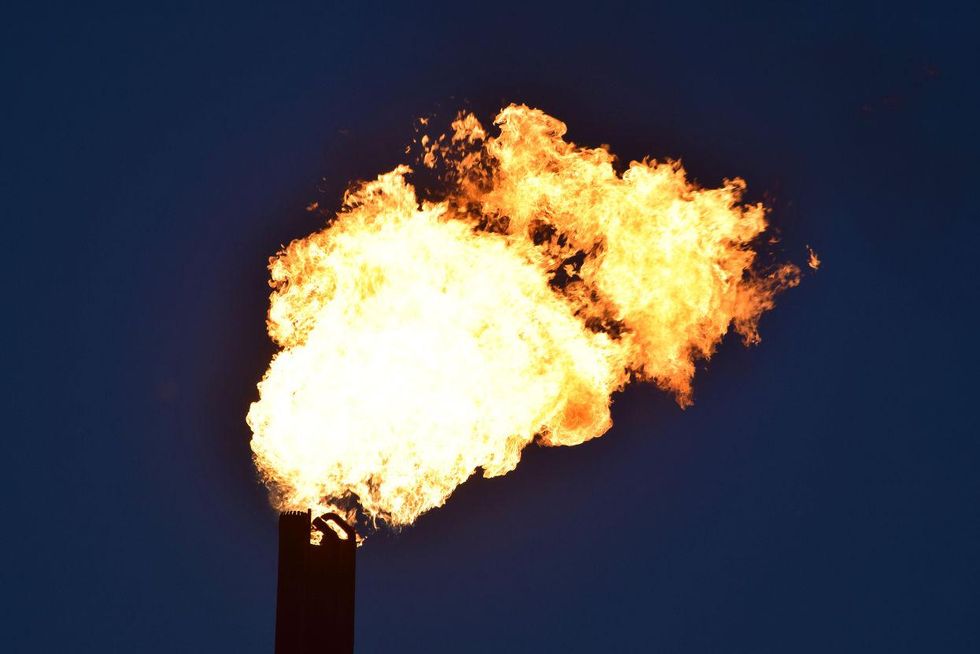
Natural gas flaring at a compressor station in Butler County, Ohio. Credit: Ted Auch, FracTracker Alliance, 2018)
The same goes for impacts to drinking water—part of a 2005 Bush/Cheney energy bill that's commonly referred to as the "Halliburton Loophole" exempted natural gas drilling from the national Safe Drinking Water Act. There have been many attempts to close this loophole, but none have succeeded.
Even where federal regulations do exist, meaningful enforcement has been lacking, especially in recent years—the Trump Administration oversaw a 70 percent decrease in criminal prosecutions under the Clean Water Act and more than a 50 percent decrease in prosecutions under the Clean Air Act.
In Pennsylvania, inadequate regulatory oversight has led to criminal charges. In the summer of 2020, following a two-year grand jury investigation, state Attorney General Josh Shapiro charged fracking giants Range Resources and Cabot with environmental crimes related to leaks, pollution, and water contamination, promising that he's still investigating "more than a dozen" criminal cases related to the oil and gas industry and that more charges are forthcoming.
The grand jury released a scathing 235-page report that documents the litany of health issues experienced by residents living near fracking sites, linking them to a long list of failures on the part of the two state agencies charged with protecting them—the Pennsylvania Department of Environmental Protection (DEP) and the Pennsylvania Department of Health (DOH). That list includes failing to adequately regulate the industry at its outset, failing to adequately train employees to respond to complaints, failing to adequately test for safety, and failing to notify residents about problems that could impact their health in a timely manner.
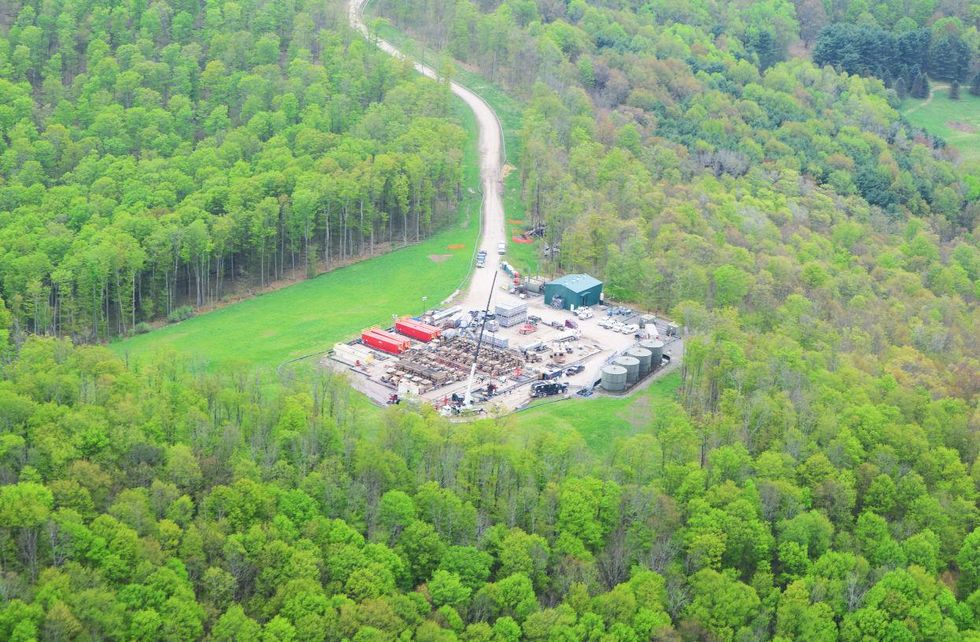
A fracking well pad in West Branch Township, Pennsylvania. (Credit: Ted Auch, FracTracker Alliance, 2019)
The Pennsylvania DEP denies those allegations and has hired outside attorneys to respond to the ongoing criminal investigations.
The report also highlighted the problem of a "revolving door" between industry and the department—DEP employees are often hired away by the industry at a much higher pay rate, creating a clear conflict of interest. In one example, the grand jury learned that a DEP employee was hired by an oil and gas company after he'd issued the same company two improper "plugging" certificates, allowing the company to shut down wells without completing the legally required work to ensure that they were safe.
"Such career progression was not uncommon," the report stated. "This sort of hiring created an unfortunate talent drain for DEP—but more concerning to us was the potential effect on the integrity of the Department's investigations."
At a press conference about the grand jury report in July, Attorney General Shapiro said "DEP and DOH have failed Pennsylvanians, particularly during the early years of the fracking boom."
This pattern has left many residents feeling that even when their complaints are investigated, the results can't be trusted. A 2017 investigation by Public Herald journalists found that of the more than 4,100 oil and gas-related drinking water complaints filed by residents over a 13-year period, the PA DEP ruled that water contamination occurring near wells was not related to oil and gas activity 93 percent of the time.
Bryan Latkanich's complaints were among them. In repeated investigations over the years, the DEP acknowledged that Bryan's water was contaminated, but ruled that Chevron—the company that drilled, operated, and recently plugged the wells on his property—was not to blame. Chevron has maintained that Bryan's issues are coincidental and have nothing to do with their wells.
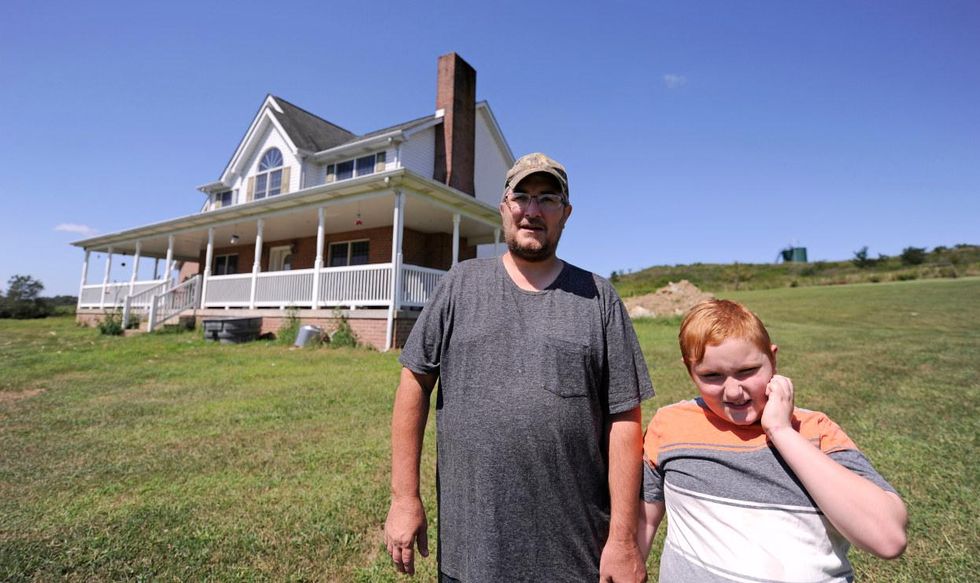
Bryan (left) and Ryan Latkanich (right) in front of their Fredericktown, Pennsylvania, home. (Credit: Connor Mulvaney for Environmental Health News)
"DEP found no evidence that oil and gas activity adversely impacted Mr. Latkanich's private water supply," DEP spokesperson Lauren Fraley told EHN, "but did alert him to sampling results that did not meet statewide health and/or aesthetic standards for his consideration."
Chevron spokesperson Veronica Flores-Paniagua told EHN, "We have taken Mr. Latkanich's concerns very seriously. Chevron has thoroughly investigated Mr. Latkanich's concerns, tested his water, and demonstrated that its operations have not affected Mr. Latkanich's water."
Regarding the cracks in the foundation, Flores-Paniagua said a Chevron-hired engineer found a crack in the foundation was the result of an improper design, and not because of Chevron's operations.
Up until now, Bryan has gotten little help figuring out what's wrong from doctors, oil and gas employees, or state agency representatives. In 2019, EHN collected urine samples, along with air and water samples, from five families in southwestern Pennsylvania—including Bryan and his son—and had them analyzed for chemicals associated with fracking.
Now for the first time, Bryan has clear evidence that he and Ryan are being exposed to harmful chemicals.
High exposures, nowhere to turn
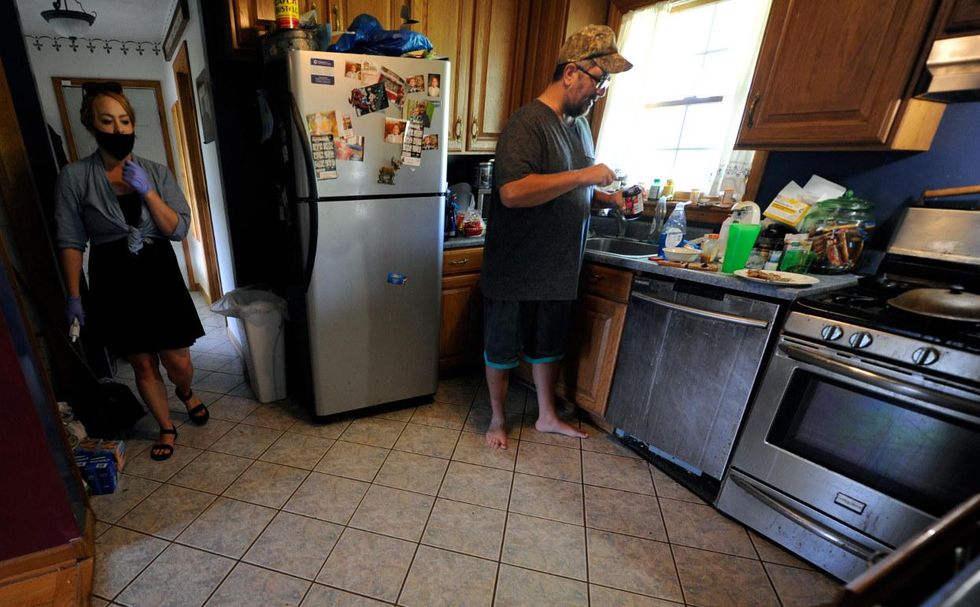
Bryan Latkanich makes breakfast in his Fredericktown, Pennsylvania, home in the summer of 2019 while Environmental Health News reporter Kristina Marusic prepares to package urine samples for freezing and shipping. (Credit: Connor Mulvaney for Environmental Health News)
EHN collected three water samples, four air monitoring samples, and six urine samples over a 5-week period from Bryan and his son Ryan, a precocious redhead who was 9 years old at the time.
We found 12 chemicals that are commonly emitted from fracking sites in one or more of their urine samples, including benzene, toluene, naphthalene, and lesser- known compounds linked to negative health impacts including respiratory and gastrointestinal problems, skin and eye irritation, organ damage, reproductive harm, and increased cancer risk.
Read about how we conducted our study
Some chemical exposures aren't detectable in urine if the body has already processed them, so we also looked for breakdown products, or biomarkers, for harmful chemicals. Some of these biomarkers show up when people consume certain foods or beverages, so to determine whether the levels we saw in Pennsylvania families were normal, we compared them against those seen in the average American using U.S. Centers for Disease Control and Prevention's (CDC's) National Health and Nutrition Examination Survey.
We found that urine samples for Bryan and Ryan also contained biomarkers of other fracking chemicals at levels higher than the U.S. 95th percentile—the value that 95 percent of Americans fall below, according to that CDC data.
All six of Bryan and Ryan's urine samples exceeded the U.S. 95th percentile for mandelic acid, and phenylglyoxylic acid, both of which are biomarkers for ethylbenzene and styrene. Four of the six samples exceeded the U.S. 95th percentile for trans, trans-muconic acid, a biomarker for benzene.

Ryan (left) and Brian Latkanich (right) near a natural gas well in the backyard of their Fredericktown, Pennsylvania, home. (Credit: Connor Mulvaney for Environmental Health News)
Exposure to these compounds is linked to eye, skin, respiratory and gastrointestinal irritation; neurological, immune, kidney, cardiovascular, blood, and developmental disorders; hormone disruption; and increased cancer risk.
On July 24, 2019, Ryan had a level of hippuric acid in his urine more than 91 times as high as the U.S. median and nearly five times as high as the U.S. 95th percentile. Hippuric acid is a biomarker that forms when the body is exposed to toluene, which is linked to skin, eye, and respiratory irritation; drowsiness and dizziness; and, with chronic exposure, infertility, reproductive harm, and damage to the nervous system, liver, and kidneys.
Both Bryan and Ryan spent July 24, 2019 at home, watching TV, using the computer, and sitting on the porch.
There's no way to know for certain whether the family's exposures came from fracking emissions. But EHN visited their home, had them complete an extensive survey about other possible sources of exposure, and recorded their activities around the time of our sampling and did not find other obvious explanations. Bryan uses chewing tobacco, which may have contributed to some of his exposures, but not Ryan's.
On July 24, 2019, Ryan's urine sample also showed a level of mandelic acid—a biomarker of ethylbenzene and styrene—nearly 42 times as high as the U.S. median and nearly 13 times as high as high as the U.S. 95th percentile. He also showed a level of 4-methylhippuric acid, a biomarker of xylene, nearly 13 times as high as the general U.S. median and nearly three times as high as the 95th percentile for 6 to 11-year-olds nationally.
Bryan's sample that day also showed a high level of mandelic acid—more than 12 times as high as the U.S. median and nearly four times as high as the 95th percentile.
On August 19th, 2019, Ryan's urine sample showed a level of trans, trans-muconic acid—a biomarker for benzene, which increases cancer risk—that was more than 28 times as high as that of the average adult cigarette smoker.
"These results are pretty shocking," Bryan said. "I don't know what else these exposures could possibly be from except the wells. In summertime when Ryan isn't in school, we both spend 99 percent of our time right here at home."
On two of the days we collected urine samples, Bryan and Ryan both wore personal air monitors for six to eight hours. We looked for 40 chemicals that are commonly emitted from fracking sites and compressor stations, and found detectable levels of each of the 40 chemicals at least once across Bryan and Ryan's air samples. On July 24, 2019, Bryan's sample showed detectable levels of all 40 chemicals.

Bryan and Ryan Latkanich in front of the fracking infrastructure that was formerly on their property in the summer of 2019. (Credit: Kristina Marusic for Environmental Health News)
Only a handful of these chemicals have regulatory limits, most of which pertain to short-term workplace exposures. Bryan and Ryan's air samples exceeded one regulatory threshold for three chemicals—the recommended limits on benzene, ethylbenzene, and naphthalene exposure set by the California Office of Environmental Health Hazard Assessment to minimize cancer risk.
On August 5, 2019, Ryan's air monitor recorded the highest levels of benzaldehyde, m/p-ethyltoluene, and 1-dodecanol seen among the 39 air samples EHN collected from five households. Exposure to these chemicals has been linked to dizziness and skin, eye, and respiratory irritation.
"When you have a whole host of chemicals like you found, you have to consider the cumulative impact," Wilma Subra, an environmental scientist and founder of the environmental consulting firm the Subra Company, told EHN. "You can't just look at one chemical and say, 'this was below the health standard so that's ok'—you have to look at the cumulative impact of the other 20 chemicals present. Even at low concentrations you can have health impacts, and when you add it all together, there can be a severe impact on people's health."
Toluene was also detected in both Bryan and Ryan's air samples, mirroring the high levels of biomarkers of toluene that were found in their urine. The levels of toluene detected in their air samples varied widely from day to day.
"Usually the only time you get a range of toluene like that in the atmosphere is if you're seeing a plume," John Graham, a senior scientist with the Clean Air Task Force, told EHN. "This could imply that there's a source that was emitting toluene and that people were exposed to it on the days when it looks really high."
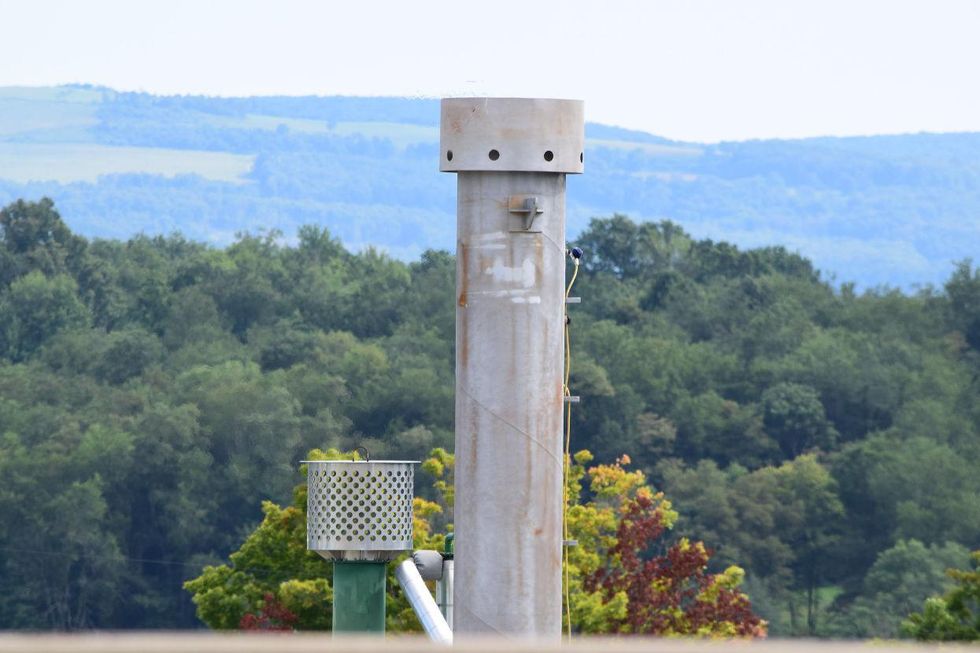
A compressor station in Donegal, Pennsylvania. (Credit: (Ted Auch, FracTracker Alliance, 2015)
EHN's investigation also found detectable levels of 12 of the 40 chemicals we looked for in Bryan and Ryan's water—things like butyl cyclohexane, tetradecane, and naphthalene. Most of the chemicals we looked for are unregulated, so there is no legal limit for them in drinking water.
Some states set health advisory limits for chemicals that aren't officially regulated. Vermont recommends no more than 0.5 micrograms per liter of naphthalene in drinking water to avoid health effects including increased cancer risk. The highest level of naphthalene we detected in the Latkanich's water was 6.96 micrograms per liter.
Because of the DEP's determinations about his water, Bryan says he's been spending up to $70 a month on bottled water for the better part of a decade. He's thought about connecting to the municipal water, but he's afraid it wouldn't be better. They treat the water with chloramine, which he fears could further damage his already unhealthy kidneys (water treated with chloramine is generally considered safe for people with kidney issues to drink, though it can't safely be used in dialysis machines), and there have also been numerous reports of fracking wastewater contaminating the local water supply. Ryan's school, Bethlehem-Center, also has a history of water contamination, and as many as 12 students in the district have had childhood cancer, so Bryan sends him to school with bottled water.
Despite these precautions, they still have to bathe in the well water. More than once, Ryan has come out of a bath or shower with sores all over his body. When Bryan reported this to the Pennsylvania Department of Health (DOH), the agency suggested Bryan and Ryan stop showering at home and instead shower at the nearest YMCA—which is an almost 30-minute drive one way.

EHN reporter Kristina Marusic looks at photos Bryan Latkanich took of his son, Ryan, with sores on his face after bathing in the summer of 2019. (Credit: Connor Mulvaney for Environmental Health News)
DOH spokesperson Nate Wardle declined to answer specific questions about Bryan and Ryan's case. "When a resident contacts us, we can help them in interpreting the results of testing done on their water source, but do not provide medical advice," he told EHN.
Wardle said the agency encourages people with problems like Bryan to use DOH's oil and gas health registry. In response to criticism that it was hard to find and confusing to navigate, the agency recently made improvements to the registry, but it remains under-utilized—in the first three quarters of 2020, they'd only received seven complaints (data for the full year hasn't yet been published), and the agency has documented a total of just 132 formal health complaints since 2011.
In the absence of a meaningful state registry for health-related oil and gas complaints, the nonprofit Southern Pennsylvania Environmental Health Project* (EHP) has collected hundreds of complaints of health symptoms experienced by residents of southwestern Pennsylvania who live near fracking wells. In 2017 they analyzed 135 health assessments conducted between 2012 and 2015, and found that the most commonly reported symptoms were sleep disruption, headache, throat irritation, stress or anxiety, cough, shortness of breath, sinus problems, fatigue, nausea, and wheezing.
The organization's executive director, Alison Steele, said that much of their work fills the gap left by the absence of a county health department or an attentive state health department—a sentiment echoed in the Attorney General's grand jury report on fracking.
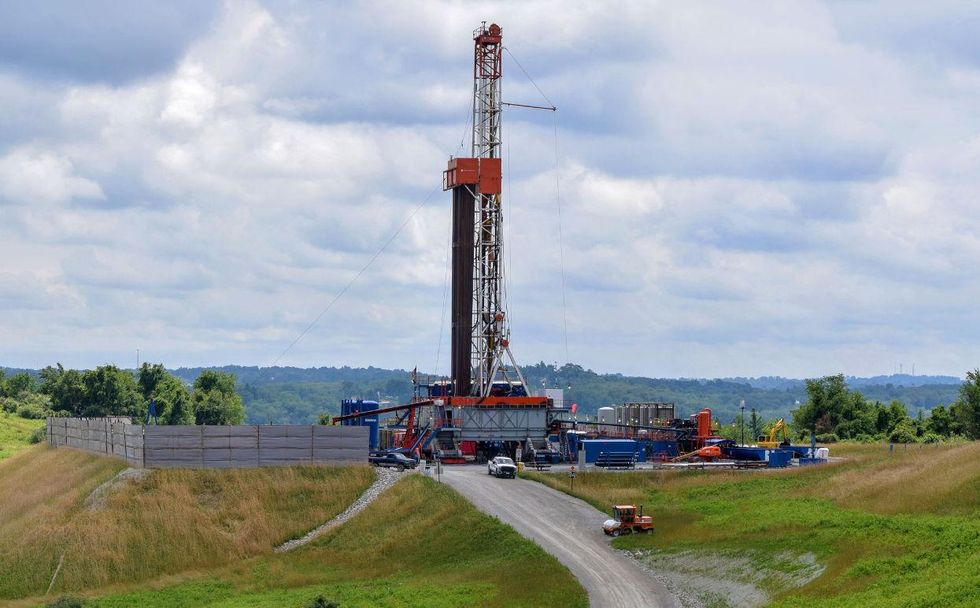
A drilling rig in Washington County, Pennsylvania. (Credit: Ted Auch, FracTracker Alliance, 2016)
"We find that EHP's actions stand in stark contrast to DOH's: the government agency charged with protecting public health," the jurors wrote. "We further find it remarkable that a newly created organization like EHP swiftly gathered data and provided guidance to Pennsylvanians on how they could protect themselves from the effects of industry operations, while a long-established government entity, DOH, did not."
Only six of Pennsylvania's 67 counties have their own health departments (Allegheny, Bucks, Chester, Erie, Montgomery, and Philadelphia). The cities of Allentown, Bethlehem, Wilkes-Barre, and York also have their own municipal health departments. State-run health centers in 59 counties provide vaccines and disease testing, but offer few other services and are unable to respond to complaints about health issues related to the oil and gas industry.
"We speak with a lot of people who feel very unheard," Jessa Chabeau, the Appalachian regional manager at the Southwest Pennsylvania Environmental Health Project told EHN. "Having a local health department, or even a regional health department that managed a couple of counties instead of the whole state would probably be more attuned to local issues."
Across the country, fracking often takes place in rural communities with similarly limited healthcare resources.
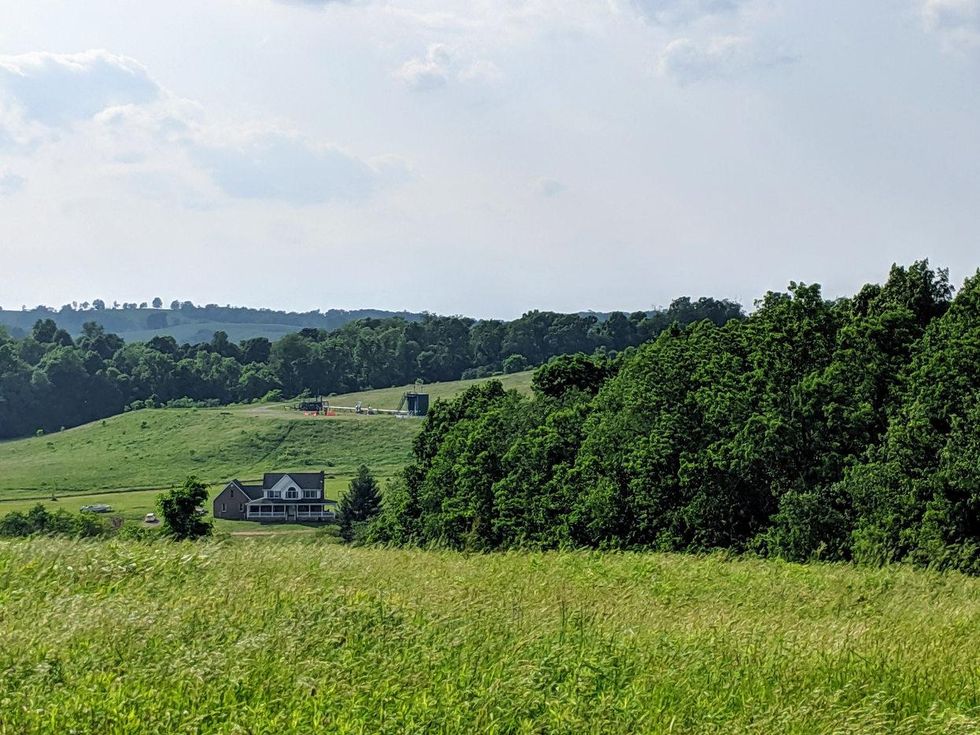
A bird's-eye view of Bryan and Ryan Latkanich's home and the fracking well pad up the hill behind it it in the summer of 2019. (Credit: Kristina Marusic for Environmental Health News)
In North Dakota, the early fracking boom put tremendous strain on the state's healthcare system (mostly due to the sudden influx of uninsured workers): The number of traumatic injuries reported in the oil patch increased 200 percent from 2007-2012, ambulance calls in one heavily-fracked district increased 59 percent from 2006 to 2011, and 12 medical facilities in western North Dakota saw their combined debt rise by 46 percent from 2011 to 2012 fiscal years. Texas is facing a rural healthcare crisis that leaves people who live amidst oil wells with limited access to care—more than one-fifth of the state's 254 counties have only one doctor or none at all. A 2020 report from the Pew Charitable Trusts found that nationwide, at least 179 rural hospitals have closed since 2005—with more than 70 percent closing since 2012.
Bryan also feels that doctors have failed to protect him and Ryan. There are very few medical toxicologists in the greater Pittsburgh region. Bryan called the one his insurance would cover repeatedly for weeks until he managed to get Ryan an appointment with University of Pittsburgh Medical Center (UPMC) Dr. Michael Abesamis in spring of 2018.
The doctor returned a written report stating that Ryan had "possible hydrocarbon exposure," and advising that as treatment, he should "stay away from his exposure source (the house site—air and water) as much as is possible."
"So basically the toxicologist's only advice was to move," Bryan said, "which we can't afford to do."
Paranoia and distrust
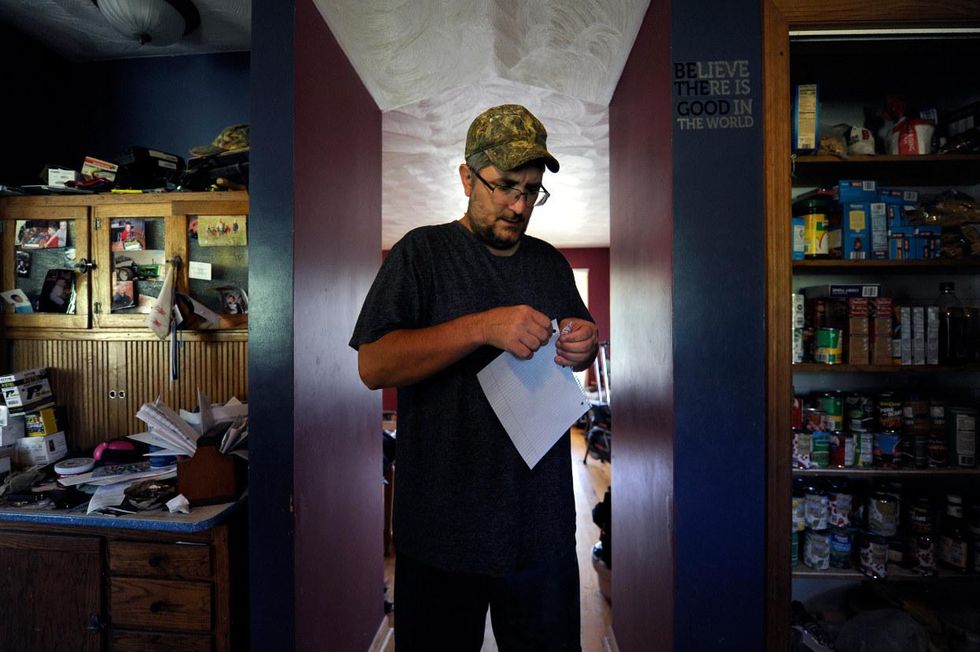
Bryan Latkanich in his Fredericktown, Pennsylvania, home. (Credit: Connor Mulvaney for Environmental Health News)
Bryan and Ryan live in a sprawling, white, custom-built farmhouse with an attached 2.5 car garage and a wraparound porch. The house sits on a picturesque hillside overlooking a small pond on the 33-acre farm. In summer, sunflowers grow all over the yard. Bryan has let Ryan plant seeds wherever he wanted because it helps hide the well pad behind their home from view.
"We don't want to look at that mess," Ryan said, "this way we can just look at the flowers instead."
There are stacks of American Rifleman magazine and books of children's Bible stories on the coffee table in the living room. There's a framed painting of Jesus Christ on the wall bearing text that reads, "Pray more, worry less." The first time I met Ryan, he proudly proclaimed, "I'm the countriest kid you ever met."
Bryan had the house built in 2000 with money from an inheritance. He planned to make it the family homestead for future generations.
"That plan is gone," he said. "We can barely live here now."

Bryan and Ryan's dog, Digby, resting on their front porch. (Credit: Kristina Marusic for Environmental Health News)
Bryan woke up one day in March 2020 to find construction vehicles at the well pad. When he asked what was going on, a Chevron employee told him the wells were being plugged.
More than 250 North American oil and gas producers have filed for bankruptcy since the beginning of 2015. As part of that shrinkage, numerous large fracking companies have left Pennsylvania, including Chevron, which announced in December 2019 that it would sell it's Appalachian Marcellus Shale and Utica Shale assets—roughly 890,000 acres in Pennsylvania, Ohio, and West Virginia.
The company closed its office in Coraopolis, a Pittsburgh suburb, and laid off about 300 employees. In October 2020, EQT Corp, the largest natural gas producer in the nation (headquartered in Pittsburgh), announced it would purchase Chevron's Appalachian assets for $735 million. Bryan's wells, which have now been filled with concrete, are not among those assets.
"It's a huge relief to have them gone," Bryan said, "but I know this isn't over yet."
Chevron maintains that they've operated in good faith, but at this point Bryan doesn't trust them—or any other fracking company, for that matter. And he isn't alone.
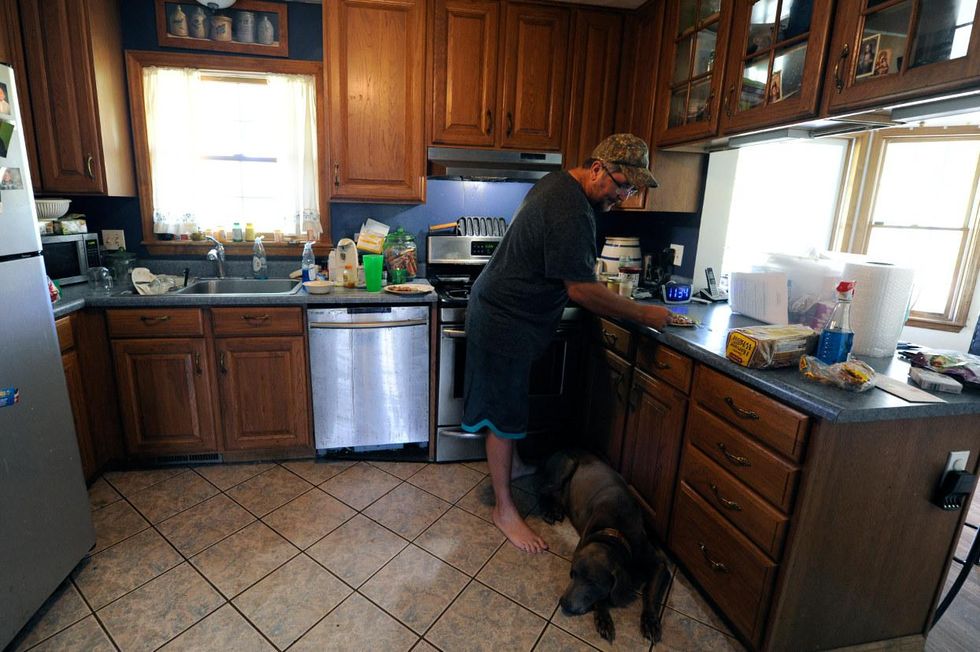
"It's a huge relief to have them gone, but I know this isn't over yet." (Credit: Connor Mulvaney for Environmental Health News)
"We hear a lot about distrust and paranoia toward the industry from community members," Hannah Blinn, a former environmental health educator and fellow at the Southwest Pennsylvania Environmental Health Project, told EHN. "We've even had people tell us they think industry reps have stolen their air monitors."
In the course of conducting interviews for this project, we heard from residents of Washington County who fear the industry is infiltrating local governments, spying on community Facebook groups, and plotting cover-ups of spills and illegal emissions in cahoots with state agencies like the DEP and DOH. Studies on the mental health impacts associated with fracking suggest that fear, distrust, and paranoia about the industry's impacts is common in fracked communities throughout the U.S.
Meanwhile, oil and gas companies go to great lengths to make clear the benefits they bring to communities.
"One thing that's changed these communities is the gas industry's charitable giving," Republican Pennsylvania Senator Gene Yaw, who chairs the state Senate Environmental Resources and Energy Committee, told EHN. "In one of my counties the oil and gas industry is responsible for leading an effort to build a new hospital. Today one of the companies is making a presentation to a volunteer fire department about giving them funds to buy new emergency equipment. Things like that go on all the time—they're the norm now."
EHN reached out to the Marcellus Shale Coalition, a regional industry trade group, for insights about ways the industry strives to protect people from potential emissions and to invite comment on our study's findings. Their response revealed that sometimes those within the industry experience mistrust and paranoia, too.
Former Marcellus Shale Coalition president David Spigelmyer (who retired in January 2021) responded with an email calling EHN biased and deriding the author, the publication, its funders, and our research. He dismissed our findings indicating potential exposures out of hand and accused EHN of intentionally "peddl[ing] misinformation and fear aimed at driving clicks to [our] site." (As a nonprofit newsroom, EHN does not benefit financially from clicks.)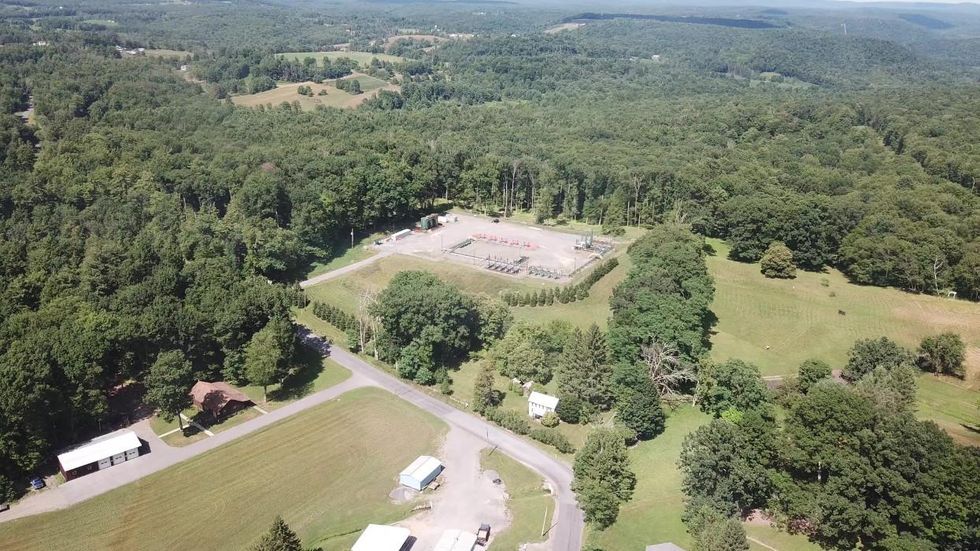
A fracking well pad near two homes in Gamble Township, Pennsylvania. (Credit: Ted Auch, FracTracker Alliance, 2020)
The president of a similar group in the Western U.S. struck a different tone.
"Any energy source has an impact on the environment, from mining to wind and solar," Kathleen Sgamma, president of Western Energy Alliance, told EHN. "The key is to minimize that risk, which happens especially well with the oil and gas industry because it's so heavily regulated. If companies make a mistake and have a spill or too much pollution, they're not only held liable under the law, but they also get lots of bad publicity. It is absolutely in a company's best interest to comply with environmental standards and be good corporate citizens."
A similar national organization, the American Petroleum Institute (API), has developed more than 700 standards for the industry aimed at promoting safety and efficiency over its 100-year history.
"As an industry we rely on data, facts and science, and we put that in practice every day by employing thousands of scientists and engineers," API spokesperson Emily Smith told EHN. "It is our top priority to protect the health and safety of the communities and environment in which we operate, and we follow industry best practices, standards and government regulations to ensure strong environmental and public health protections."
As for Bryan, he doesn't think it should matter what a corporation's true motivations are or even how honest they are—people who live in fracking communities should be able to rely on local and state governments for protection.
"Everything would be different here if regulators actually did their jobs and defended the Pennsylvania constitution, which guarantees me as a resident the right to clean air and pure water," he said. "Instead they protect and defend fracking companies, which are always just looking at the bottom line."
A major mission change
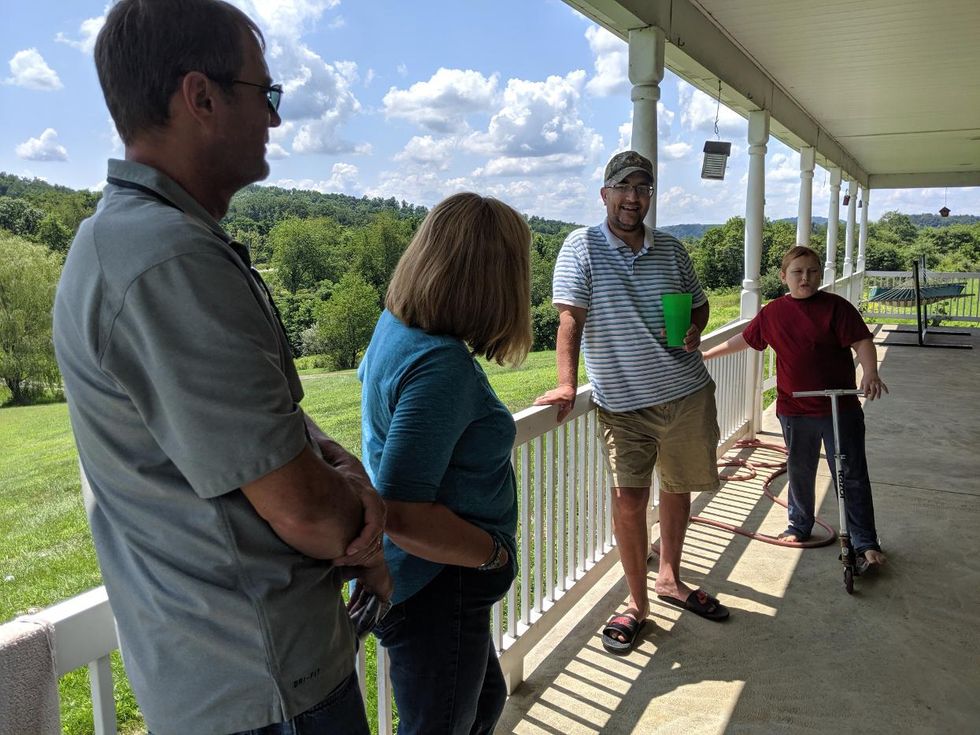
Bryan Latkanich talks with fellow Washington County residents Kurt and Janice Blanock on his front porch in the summer of 2019. In 2016 the Blanock's son Luke died of Ewing sarcoma, a rare cancer, at the age of 19. (Credit: Kristina Marusic for Environmental Health News)
Matt Mehalik, executive director of the Breathe Project, a coalition of 46 environmental organizations in the Pittsburgh region, told EHN he was saddened but not surprised by the results of EHN's research.
"To see this kind of proof that people who have endured terrible health issues have had these kinds of exposures from those bad decisions and actions is heartbreaking," he said. "What your study has done is the work that someone who actually works for a health agency should probably do."
While a large body of scientific research has linked living near fracking to numerous health effects, state governments approach these studies in very different ways.
The state of New York banned fracking outright in 2014 on the basis of 400 peer-reviewed studies showing potential health harms from the industry (As of August 2020, there were 2,015 studies indicating potential harm). Other states that have looked to the science on both health and climate change impacts and passed permanent or temporary bans on fracking include Vermont, Washington, Maryland, and Oregon. France, Bulgaria, the Netherlands, Germany, Ireland, Wales, the United Kingdom, Uruguay, Brazil, Colombia, and Costa Rica have also passed fracking bans.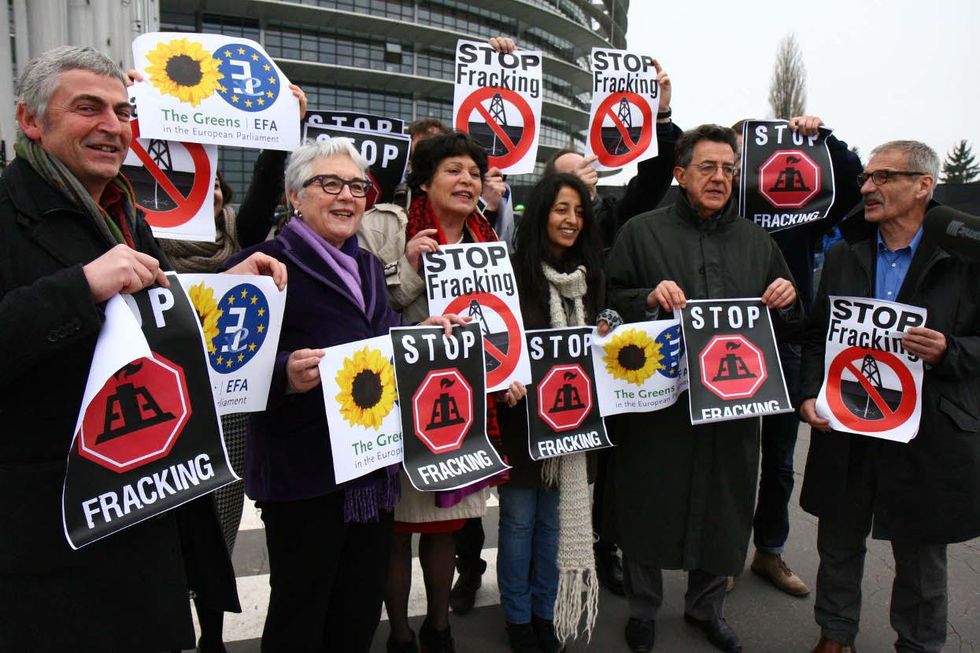
A 2012 fracking protest outside of European Parliament. (Credit: Greens EFA/Flickr)
In contrast, states with economies that already rely heavily on the fracking industry are often more reluctant to take a precautionary approach.
A 2017 study by the Colorado Department of Public Health and Environment looked at available scientific studies, determined that only 12 of them were scientifically rigorous enough to use, and concluded that there is "limited" and "insufficient" evidence of health harms from exposures associated with oil and gas operations. In 2019, Colorado conducted another literature review in collaboration with the Pennsylvania DOH, which also found little evidence of harm. That review was criticized by the Southwest Pennsylvania Environmental Health Project for including just 20 peer-reviewed studies.
In the last year, though, things have changed drastically in Colorado.
Colorado state toxicologist Kristy Richardson, who co-authored the 2019 literature review in collaboration with the DOH, told EHN that many studies were excluded because of how difficult it is to determine with scientific certainty whether health issues experienced by people living near fracking wells are being caused by exposures associated with the wells, other environmental exposures, or lifestyle factors.
"The literature reviews we did both here and with researchers in Pennsylvania pointed to a need for higher quality analysis that allow us to control for confounding factors in people's health so we can better understand what's attributable to oil and gas versus other variables in people's lives," Richardson said.
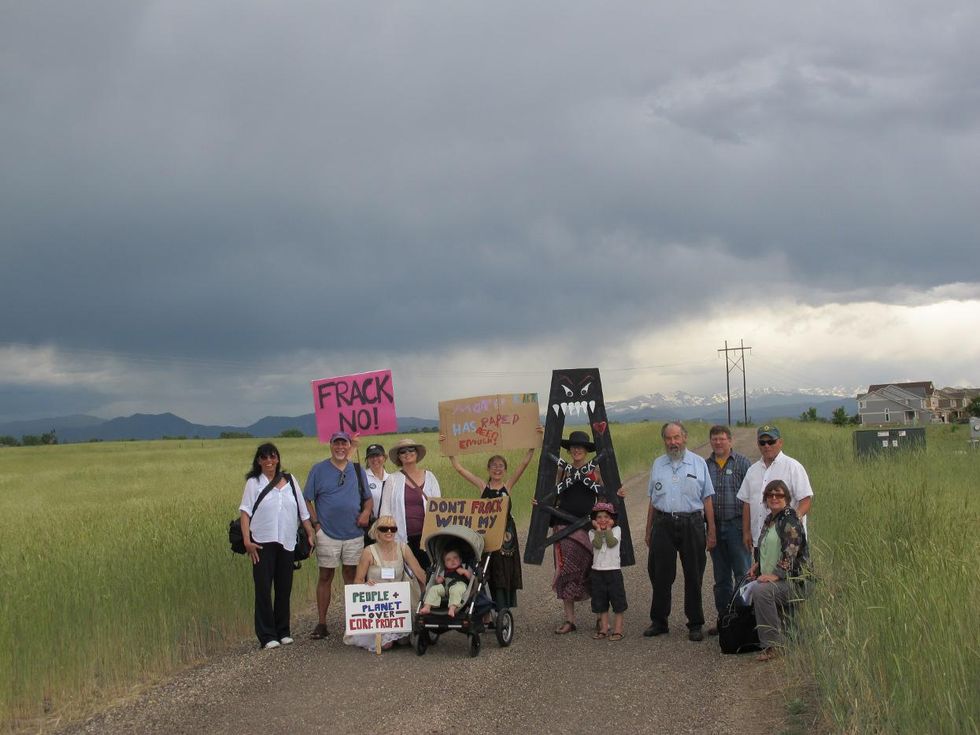
A 2011 fracking protest in Erie, Colorado. (Credit: Erie Rising/Flickr)
In an attempt to close that gap, the Colorado Department of Public Health and Environment also conducted its own multiyear study that used weather and emissions data from Colorado fracking wells to estimate the levels of harmful chemicals up to 2,000 feet from well pads under various weather conditions—things like high vs. low winds, various temperatures, and precipitation. Their findings, which were published in 2019, were groundbreaking.
"We found that during worst case weather conditions, the levels of emissions for chemicals like benzene and xylene are high enough to cause short-term health effects at every distance we studied—from 300 to 2,000 feet from oil and gas operations," Richardson explained.
These short-term health effects include things like headaches, nosebleeds, difficulty breathing and dizziness. Richardson noted that the study did not account for simultaneous exposures from multiple well pads or assess potential long-term health effects from these exposures.
Before that study came out, Colorado had already begun an overhaul of the way it regulates the industry. In April that year, Colorado Governor Jared Polis signed Senate Bill 19-181, which fundamentally changed the mission of the Colorado Oil and Gas Conservation Commission (which oversees permitting for the industry), from "fostering" oil and gas development to "regulating" the industry in a way that protects "public health, safety, and welfare, including protection of the environment and wildlife resources."
That shift combined with the new report from the state health department kicked off a barrage of policy changes.
In November 2020, following more than 180 hours of public hearings involving 93 parties representing industry groups, scientific researchers, public health officials, homeowners associations and environmental groups, the newly revamped Colorado Oil and Gas Conservation Commission announced that it would begin implementing some of the strongest fracking regulations and policies in the country. They include:
- A 2,000-foot setback distance for new unconventional oil and gas wells
- A requirement that fracking companies capture and eliminate 95 percent of harmful air pollutants released during fracking
- A requirement that emissions are monitored from the start of construction of a new fracking well through the first six months of production
- A ban on routine flaring or venting (burning off or releasing excess natural gas, which also releases toxic chemicals)
- A new system aimed at tracking the industry's cumulative impacts
- New protections for wildlife and waterways
- Increased transparency and public input
- The incorporation of environmental justice considerations (assessing the poverty rate and racial makeup of communities that will be impacted) during the permitting process
Both Richardson and John Putnam, the former environmental programs director at the Colorado Department of Public Health and Environment, said that engaging with people who live near oil and gas wells and incorporating their concerns into research and policy decisions has been critical.
"Even while we invest in a rigorous, scientific data-driven approach, we need to make sure that we're engaging with the community to really hear their concerns and communicate the science in an accessible, empathetic way," Putnam told EHN. (Putnam recently left the Colorado Department of Public Health and Environment to take a position as Deputy General Counsel for the U.S. Department of Transportation.)
He also said there's no reason states like Pennsylvania should have to reinvent the wheel.
"Colorado has some of the best air quality, public health, and climate scientists in the world doing great work and researching collaboratively," Putnam said. "I think other states could take a look at the body of work Colorado has done, from research to policy implementation, to learn from our lessons and build on our successes."
Ongoing ailments

Credit: Kristina Marusic for Environmental Health News
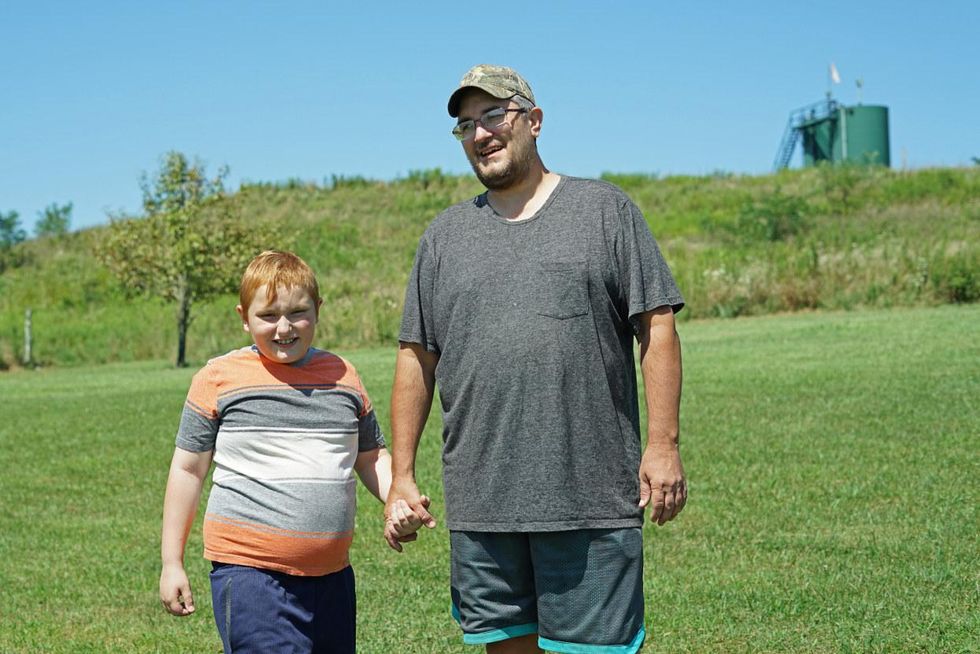
Credit: Connor Mulvaney for Environmental Health News
Despite the wells on his property being plugged, Bryan remains worried about his and Ryan's exposures.
In addition to the well pad on his property, Bryan's house is surrounded by dozens of wells and other pieces of industry infrastructure owned by numerous operators including Chevron, EQT, Range Resources, and Diversified Oil & Gas.
About a year after the wells on his property went in, Ryan was diagnosed with asthma. In the years since, he has had frequent earaches and respiratory issues, including pneumonia and bronchitis. For the last three years, he's also had bouts of vomiting and difficulty controlling his bowels.
Bryan was sick before the wells went in. He had polycystic kidney disease, and when he initially signed his lease, he'd recently woken up after having a benign brain tumor removed to learn that he was permanently blind in one eye and had impaired vision in the other. He's had a number of other symptoms emerge in the last decade, many of which began following the flaring of wells on his property. When the flaring was underway, the huge flames licking up into the air were so close to the house they could feel the heat.
"I thought the damn siding was gonna melt," Bryan said. "The flames were higher than our roof."
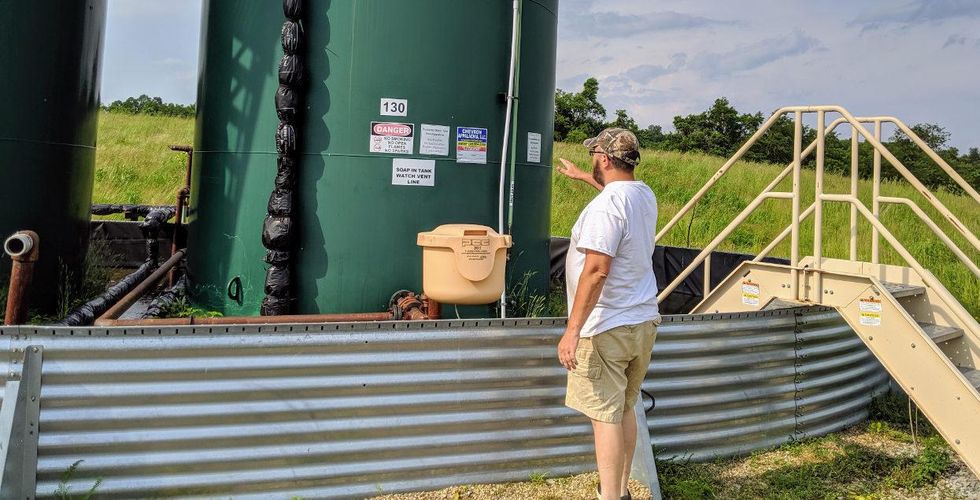
Bryan in front the fracking infrastructure that was formerly on his property. (Credit: Kristina Marusic for Environmental Health News)
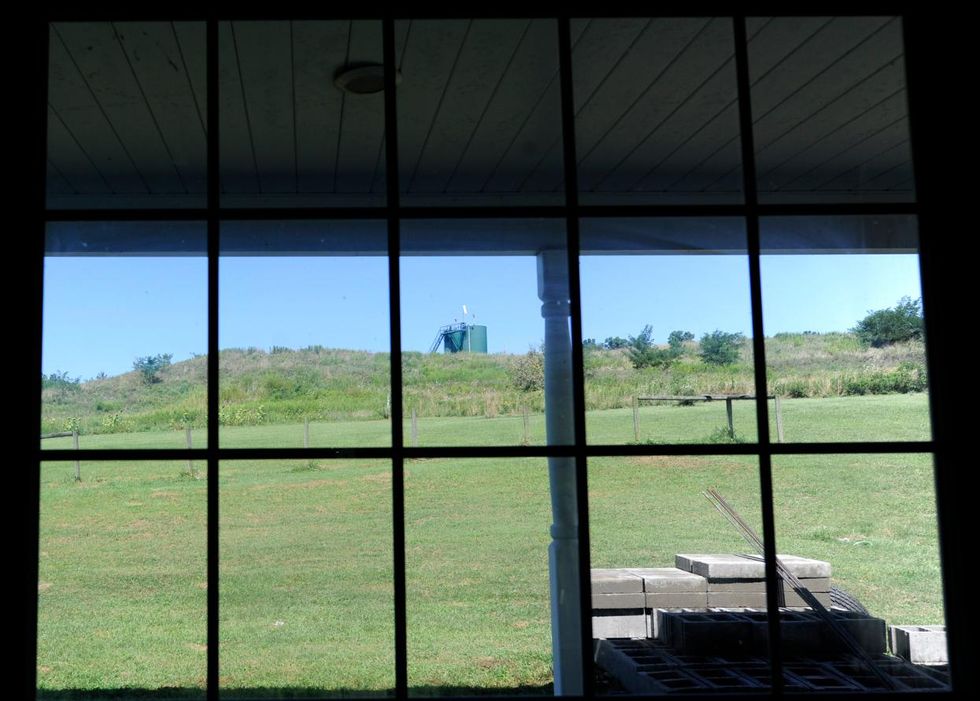
View of the well pad that was formerly on the Latkanich property from their living room window. (Credit: Connor Mulvaney for Environmental Health News)
Natural gas flaring emits a slew of toxic chemicals including benzene, formaldehyde, polycyclic aromatic hydrocarbons, acetaldehyde, acrolein, propylene, toluene, xylenes, ethyl benzene and hexane, among others. Exposure to those chemicals is linked to a host of negative health effects including increased cancer risk, respiratory and gastrointestinal irritation, endocrine disruption, and central nervous system damage. Very few studies have been conducted on the health effects of exposure to flaring specifically, but one 2020 study concluded that babies born near natural gas flaring are 50 percent more likely to be premature.
Soon after flaring began, Bryan got sick to his stomach and was diagnosed with inflammation in his intestines. He began losing all his body hair, eventually learning that he'd become sterile, and he was prescribed testosterone shots. He developed neuropathy, a type of nerve damage that causes pain and numbness in the limbs and joints, and he was diagnosed with adult onset asthma. Many of his ailments are ongoing—Bryan has been in and out of the hospital at least five times since February 2018.
It isn't just their physical health that continues to suffer. Both Bryan and Ryan feel anxious about their health, and Ryan has been bullied at school over his incontinence. Bryan has been teaching him how to box in case it ever gets physical.
Previously, Bryan planted his farmland with tomatoes, peppers, sweet corn, pumpkins, and peach, apple, cherry, plum, and pear trees to sell at local markets and farm stands. But Brian said that when restoring the parts of the property they'd disrupted, Chevron filled the land with stones and left ditches that have made it impossible to get through it with the tractor. Even if he could, he said, he'd be afraid to sell anything he grew for fear that the soil could be contaminated.
For a while, Bryan was staying up late looking for houses every night, even though they can't afford to move—they're getting by on a small pension and Bryan's disability payments.
"The house is still damaged, our health is still affected, the water's still not drinkable, and the property isn't put together," he said. "I'm glad they're gone. But I'm still not whole."
Frequently Asked Questions about Fractured: What to do, who to call, how to push for change.
Have you been impacted by fracking? We want to hear from you. Fill out our fracking impact survey and we'll be in touch.
In part 4 of the series: Pollution from Pennsylvania's oil and gas network extends far beyond fracking.
This story was fact-checked by Dani Leviss.
Editor's note: Southwest Pennsylvania Environmental Health Project (EHP) was a partner in this project, along with the University of Missouri. EHP and EHN both receive some funding from the Heinz Foundation but remain independent from the foundation.
Banner photo: Bryan Latkanich makes breakfast in his Fredericktown, Pennsylvania, home. (Credit: Connor Mulvaney for EHN)

